AMD Kaveri Review: A8-7600 and A10-7850K Tested
by Ian Cutress & Rahul Garg on January 14, 2014 8:00 AM ESTDrawing Performance Conclusions
As I progressed through the testing for this review, I became aware of trends in two things: absolute performance, in terms of numbers, and generational improvements across platforms. With AMD moving the Bulldozer based architectures from Piledriver in Trinity and Richland to Steamroller in Kaveri, the base CPU design has had a relatively long run in order to be optimized to the limitations on the CPU side. Obviously AMD has also had a chance to change the lithography node in there as well, and as such has optimized for design rather than performance. This matters a great deal when we look at the power banding (45W, 65W, 95W) and performance in each segment.
In order to display just how much Kaveri has grown in relation to the previous generations, I processed our mountain of data to show graphs where percentage gain against the older generations really does matter. As mentioned previously in this review, it all depends on whether the software can take advantage of the new features afforded by the architecture. In this review we have spent a lot of time discussing advantages for Kaveri in terms of compute (HSA, hUMA, hQ) and gaming (Mantle, TrueAudio), but some of these are still a little way off for software integration. So what does that translate to if you are looking for an APU today – does Kaveri still expand its wings with the integration of the GCN architecture, or does it lag behind due to the lithography node no longer being optimized for frequency. The proof is in the results.
IGP Gaming, 1280x1024
For the 100W APUs at 1280x1024, there is almost no movement between the Richland and the Kaveri APUs, except for Company of Heroes which would seem to leverage the extra SPs more than the MHz available.
45W APUs are clearly in vogue at 1280x1024, each of them providing a good bump over Richland.
IGP Gaming, 1680x1050
1680x1050 sees more benefit for the 100W APUs, but the 45W APUs still show big leaps.
IGP Gaming, 1920x1080
At 1080p the effects are more pronounced all around.
CPU Timed Benchmarks
Unfortunately the CPU timed benchmarks at 100W are bit over the place. Here we are dealing with an IPC gain but MHz deficit, and each benchmark has a different way of dealing with it. For Agisoft, MHz wins, but for Xilisoft, the Kaveri improvements work out well for the system.
At 45W the situation is a lot more clearer, and the newer APUs have the advantage, especially in Adobe After Effects.
CPU Score Benchmarks
45W still makes the biggest jump when it comes to score based CPU benchmarks.
IGP Synthetics
I never like putting much thought into the synthetic results – here both the 100W and the 45W range are showing good improvements all around. 3DMark 06 has the most trouble getting improvements as it relies more on the grunt, rather than the features that Kaveri affords.
IGP Compute
Off the bat we can see just how much of a difference the Kaveri GPU Compute can make over previous APUs. This is still without hUMA fully being in effect while we wait for a proper driver and software stack to become available.
Up to a +222% boost from Kaveri is amazing for a 45W part.
AMD vs Intel
For a little tete-a-tete, putting the 65W Iris Pro up against the 65W Kaveri seems like a good idea. To add to the mix, due to the extreme price difference of Iris Pro in this equation, we also add the 95 W Kaveri for comparison.
It is interesting to note that at the lower resolutions the Iris Pro wins on most benchmarks, but when the resolution and complexity is turned up, especially in Sleeping Dogs, the Kaveri APUs are in the lead.


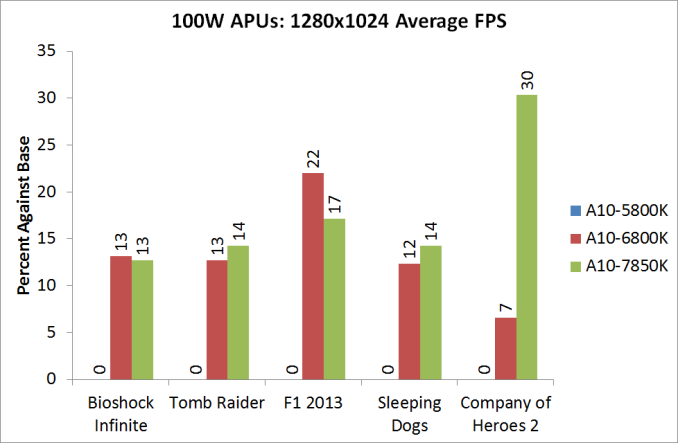
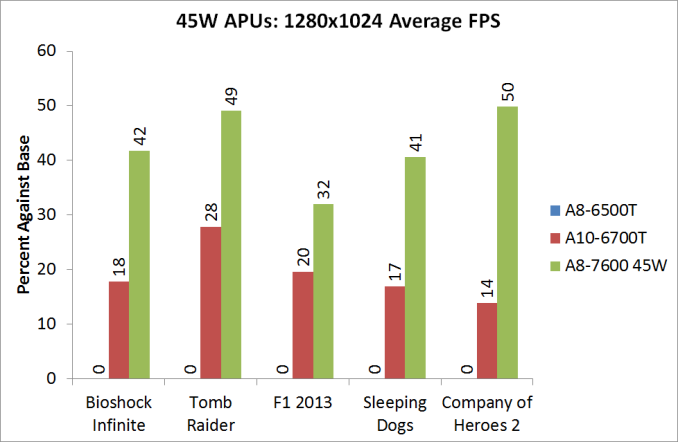
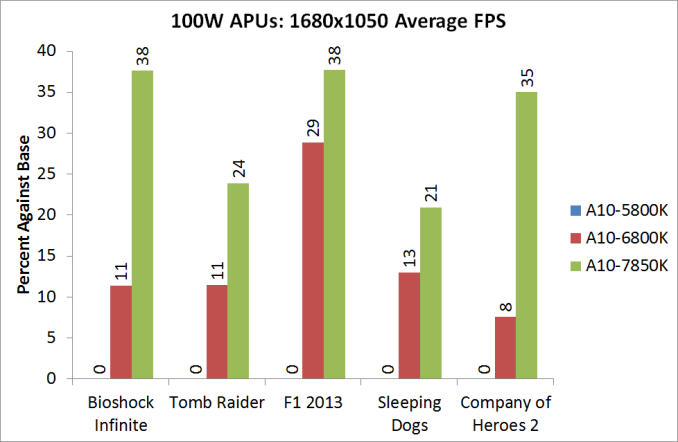
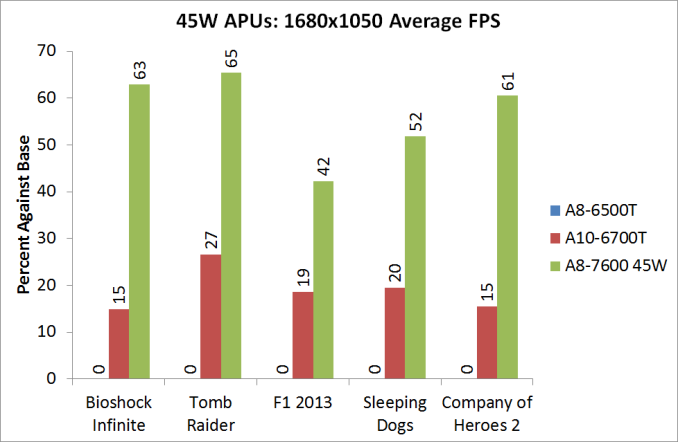
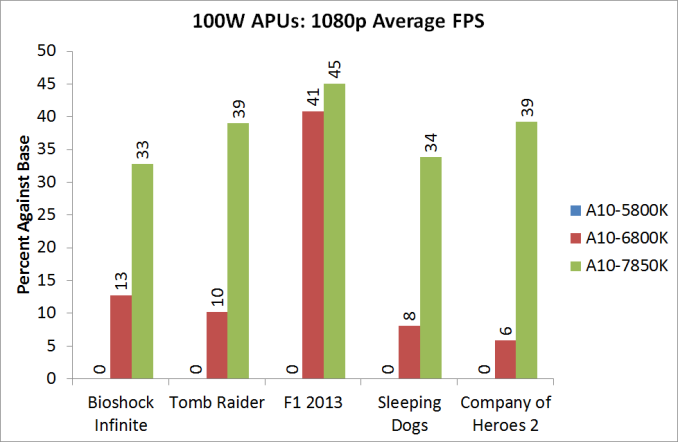

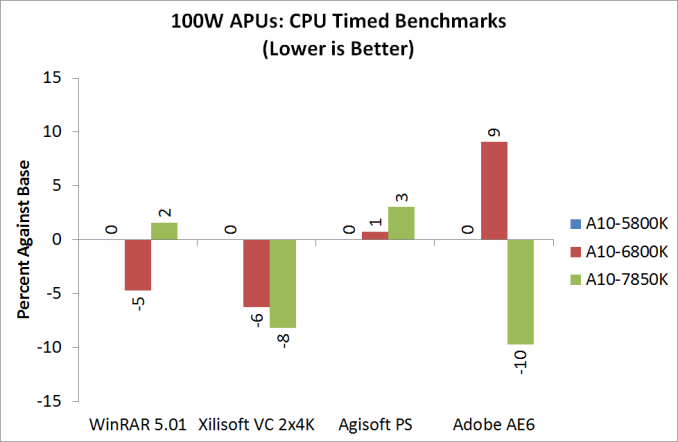
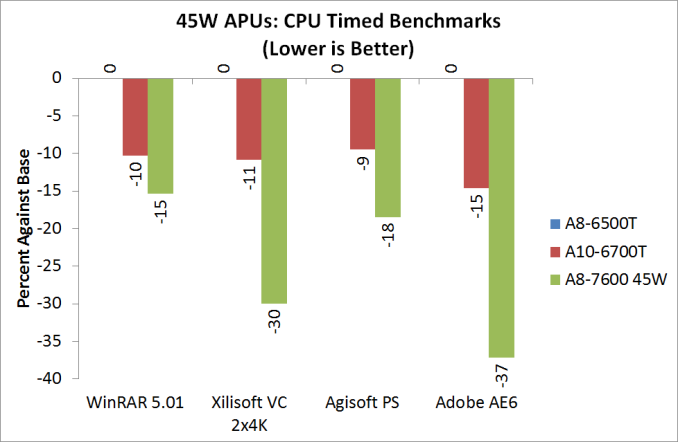

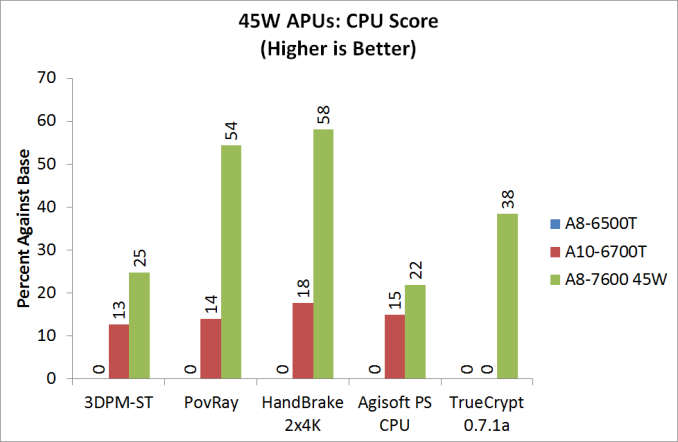
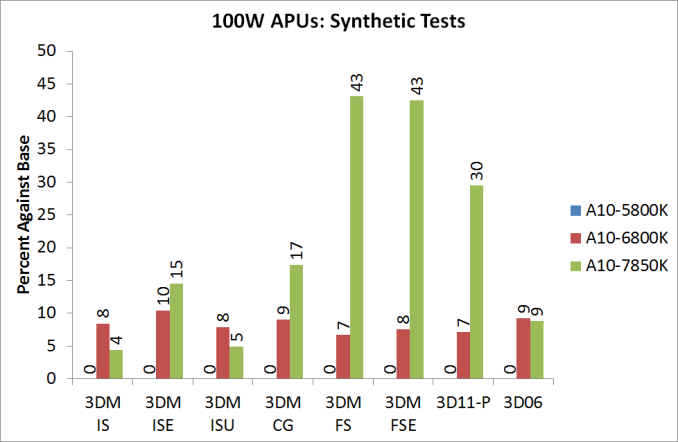
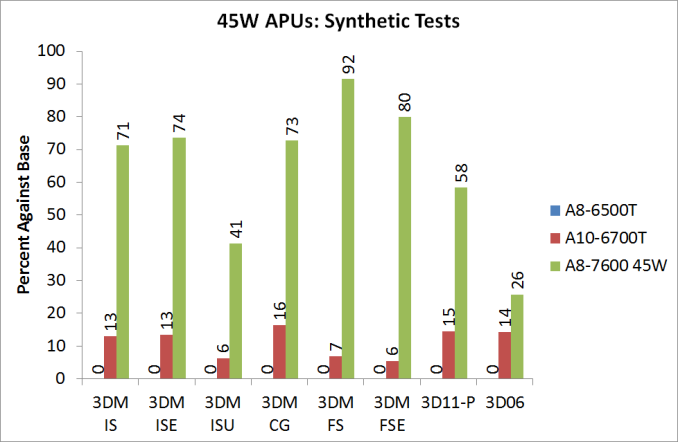
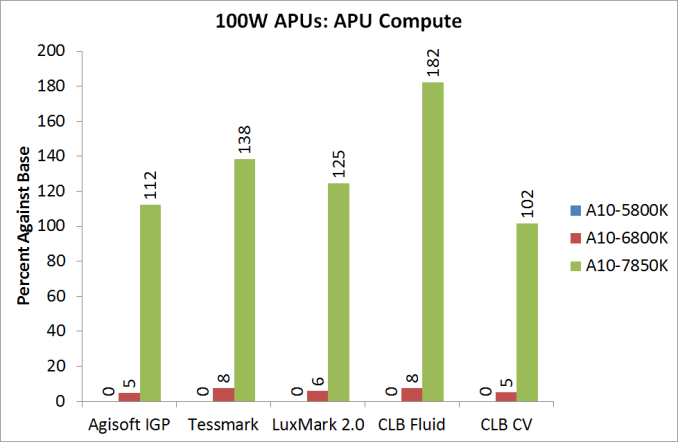

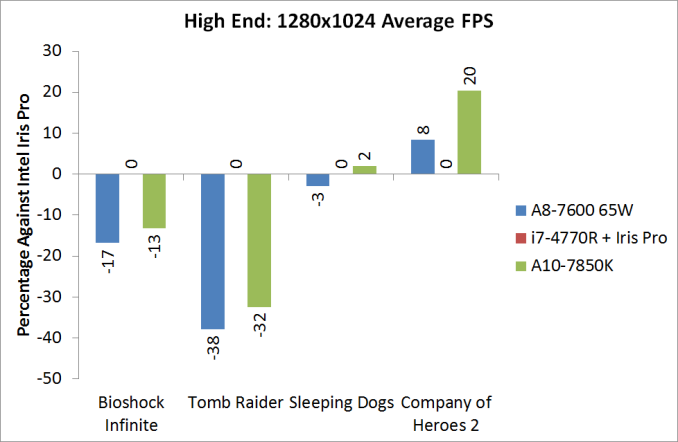
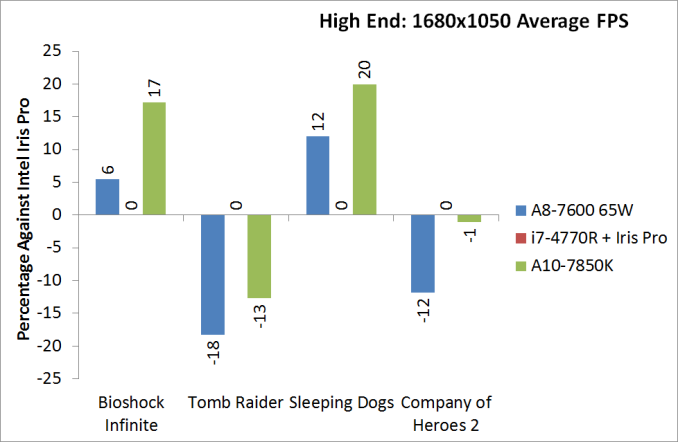
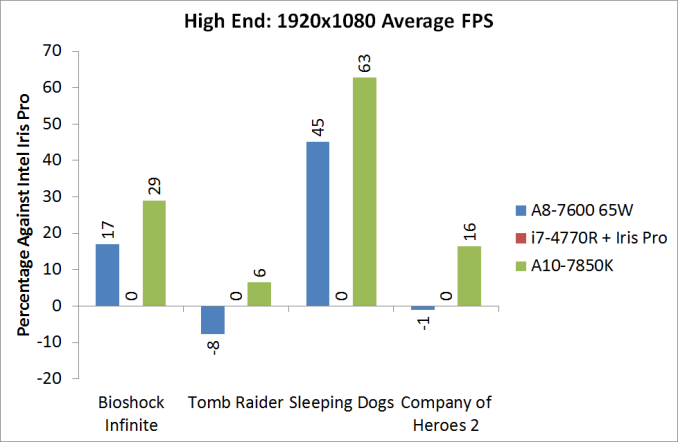








380 Comments
View All Comments
SofS - Wednesday, January 22, 2014 - link
Following your links and looking around I found:http://www.tomshardware.com/reviews/core-memory-sc...
It links to previous similar articles concerning the Phenon II and the i7 of the time (975). Seems that indeed the C2Q does not benefit much from memory improvements compared to the other two, but there is a difference. This and all of those three cases are relevant since all three models were very popular. Also, I remember choosing the on time smaller modules for my first kit whit this particular system since they were the only reasonable DDR3 modules at 1600 within reach, albeit I never managed to stabilize it at CL6. On the other hand the latter I upgraded with got CL6 from XMP since the beginning while being larger. Given that memory is very cheap compared to the whole system plus the cost of repurchasing non portable software then this (maybe also a new GPU) might just be the final push needed to wait for the next generation native DDR4 systems for many.
fokka - Tuesday, January 14, 2014 - link
i understand your sentiment, but then again, about every modern mainstream cpu should destroy a c2d and even quad in raw performance. and you even get relatively capable integrated graphics included in the package, so about everyone even moderately interested in computing performance and efficiency "should bite the bullet" if he's got a couple hundred bucks on the side.just4U - Wednesday, January 15, 2014 - link
and that's the problem.. their not. "It's good enough" Numbers are.. just that numbers. We hit a wall in 2008 (or there abouts..) and while performance kept increasing it's been in smaller increments. Over the span of several generations that really can add up but not the way it once did.It used to be you'd get on a old system and it would be like pulling teeth because the differences were very noticeable and in some cases they still are.. but for the most part? Not so much.. not for normal/casual usage. There is a ceiling .. Athlon X2s P4s? No.. you'll notice it.. Quad 8x Core2? hmmm.. How about a socket 1366 cpu or the 1156 stuff? Or the PIIs from AMD. Those people should upgrade? Certainly if their board dies and they can't replace.. but otherwise not so much.
just4U - Wednesday, January 15, 2014 - link
That should have read Quad 8x series Core2s.. anyway these days It seems like we do a lot more change out video, add in ssd, increase ram, rather then build systems from the ground up as systems can stick around longer and still be quite viable. Yes/no?tcube - Thursday, January 16, 2014 - link
Totaly agree. We're led to believe that we need to upgrade every 2 years or so... yet a great many are still using old cpu's even dual cores with new software and os without a care in the world. Because there is no noticeable improvement in cpu usage. Cpu power became irrelevant after C2Q nothing beyond that power is justifiable in normal home or office usage. Certainly certain professional users will want a cheap workstation and will buy into the highend pc market likewise extreme gamers or just for bragging rights. But thinking that for anything from browsing to medium photoshop usage or any moderate videoediting software use will REQUIRE anything past a quadcore like lowend i5's or this kaveri is plain false. You will however notice the lack of a powerful gpu when gaming or doing other gpu intensive tasks... so amd has a clear winner here.I do agree it's not suited for heavy x86 work... but honestly... most software stacks that previously relied heavily on cpu are moving to opencl to get a massive boost from the gpu... photoshop being just one of many... so yeah the powerful gpu on kaveri is a good incentive to buy, the x86 performance is better then richland which is sufficient for me(as i currently do use a richland cpu) so...
Syllabub - Friday, January 17, 2014 - link
I am not going to try and pick a winner but I follow your line of reasoning. I have a system with a e6750 C2D and Nvidia 9600 that still gets the job done just fine. It might be described as a single purpose type of system meaning I ask it to run one or possibly two programs at the same time. What I think is pretty wild is that when I put it together originally I probably sank something close to $250 into the CPU and GPU purchase while today I potentially get similar performance for under $130 or so. The hard part is buying today in a manner that preserves a level of performance equivalent to the old system; always feel the tug to bump up the performance ladder even if I don't really need it.Flunk - Thursday, January 16, 2014 - link
That doesn't really make sense unless you also include equivalently-priced current Intel processors. People may be moving on from Core 2s but they have the opportunity to buy anything on the market right now, not just AMD chips.PPB - Tuesday, January 14, 2014 - link
Adding a $350 CPU plus $50 GPU to a iGP gaming comparison = Anandtech keeping it classy.MrSpadge - Tuesday, January 14, 2014 - link
You do realize they're not recommending this in any way, just showing the full potential of a low-end discrete GPU which wouldn't be bottlenecked by any modern 3+ core CPU?Homeles - Tuesday, January 14, 2014 - link
PPB being an ignorant critic, as usual."For reference we also benchmarked the only mid-range GPU to hand - a HD 6750 while connected to the i7-4770K."